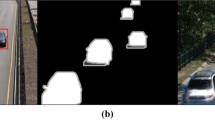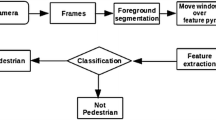Abstract
Pedestrians are the most interesting as well as vulnerable entity from both safety and security perspective in the field of video surveillance. In this article, we present a framework to detect pedestrians across a stationary camera view. Our propositions thrust upon developing a motion segmentation module and a feature extraction module for human localization. In the first stage, a background subtraction method is proposed to collect the initial set of moving objects in the processed frame. A shape descriptor is then presented to encode the pattern of human body in terms of silhouette orientation histogram. Moreover, the principle of Golden ratio is employed to formulate a part-based detector to alleviate the problem with occlusion. Both the above modules are first validated separately, and then as a unified unit, using various statistical measures. The proposed background subtraction module is simulated on twenty video clips taken from three benchmark datasets. The efficacy of our shape descriptor is validated on various image-windows taken from three publicly available datasets. The unified framework including both the modules are tested on two standard surveillance datasets. All the experimental results are uploaded at: https://sites.google.com/site/PedestriansInMotion.


























Similar content being viewed by others
References
Bar-Hillel A, Levi D, Krupka E, Goldberg C (2010) Part-based feature synthesis for human detection. In: European conference on computer vision, Springer
Barnich O, Van Droogenbroeck M (2011) ViBe: a universal background subtraction algorithm for video sequences. IEEE Trans Image Process 20(6):1709–1724
Benenson R, Omran M, Hosang J, Schiele B (2014) Ten years of pedestrian detection, what have we learned? In: European conference on computer vision. Springer, pp 613–627
Brown LM, Feris R, Pankanti S (2014) Temporal non-maximum suppression for pedestrian detection using self-calibration. In: International conference on pattern recognition. IEEE, pp 2239– 2244
Caviar: Context aware vision using image-based active recognition. http://homepages.inf.ed.ac.uk/rbf/CAVIAR/
Cho H, Rybski PE, Bar-Hillel A, Zhang W (2012) Real-time pedestrian detection with deformable part models. In: Intelligent vehicles symposium (IV). IEEE, pp 1035–1042
Dalal N, Triggs B (2005) Histograms of oriented gradients for human detection. In: IEEE Computer society conference on computer vision and pattern recognition, vol. 1. IEEE, pp 886–893
Dollár P, Belongie SJ, Perona P (2010) The fastest pedestrian detector in the west. In: BMVC, vol. 2. Citeseer, p 7
Dollár P, Tu Z, Perona P, Belongie S (2009) Integral channel features
Dollar P, Wojek C, Schiele B, Perona P (2012) Pedestrian detection: an evaluation of the state of the art. IEEE Transactions on Pattern Analysis and Machine Intelligence 34(4):743–761
Enzweiler M, Gavrila DM (2009) Monocular pedestrian detection: Survey and experiments. IEEE Transactions on Pattern Analysis and Machine Intelligence 31 (12):2179–2195
Errami M, Rziza M (2016) Improving pedestrian detection using support vector regression. In: 13Th international conference on computer graphics, imaging and visualization. IEEE, pp 156–160
Everingham M, Van Gool L, Williams CK, Winn J, Zisserman A (2010) The pascal visual object classes (voc) challenge. Int J Comput Vis 88(2):303–338
Felzenszwalb P, McAllester D, Ramanan D (2008) A discriminatively trained, multiscale, deformable part model. In: IEEE Conference on computer vision and pattern recognition. IEEE, pp 1–8
Felzenszwalb PF, Girshick RB, McAllester D, Ramanan D (2010) Object detection with discriminatively trained part-based models. IEEE Transactions on Pattern Analysis and Machine Intelligence 32(9):1627–1645
Fernandez-Sanchez EJ, Diaz J, Ros E (2013) Background subtraction based on color and depth using active sensors. Sensors 13(7):8895–8915
Finlayson GD, Hordley SD, Xu R (2005) Convex programming colour constancy with a diagonal-offset model. In: IEEE International conference on image processing, vol. 3. IEEE, pp III–948
Gerónimo D., Sappa A, López A., Ponsa D (2007) Adaptive image sampling and windows classification for on-board pedestrian detection. In: International conference on computer vision systems, vol. 39. Bielefeld, Germany
Gevers T, Smeulders A (1999) Color-based object recognition. Pattern Recogn 32(3):453–464
Goyette N, Jodoin PM, Porikli F, Konrad J, Ishwar P (2012) Changedetection. net: a new change detection benchmark dataset. In: Computer vision and pattern recognition workshops. IEEE, pp 1–8
Hati K, Sa P, Majhi B (2013) Intensity range based background subtraction for effective object detection. IEEE Signal Processing Letters 20(8):759–762
Heikkila M, Pietikainen M (2006) A texture-based method for modeling the background and detecting moving objects. IEEE Transactions on Pattern Analysis and Machine Intelligence 28(4):657–662
Hubert M, Vandervieren E (2008) An adjusted boxplot for skewed distributions. Comput Stat Data Anal 52(12):5186–5201
Jeon H, Jeong J, Bang J, Hwang C (2008) The efficient features for tracking. In: 20Th IEEE international conference on tools with artificial intelligence, vol. 1. IEEE, pp 241–244
Ji X, Liu H (2010) Advances in view-invariant human motion analysis: a review. IEEE Trans Syst Man Cybern Part C Appl Rev 40(1):13–24
Li L, Huang W, Gu I, Tian Q (2003) Foreground object detection from videos containing complex background. In: ACM International multimedia conference and exhibition. pp 2–10
Li L, Wang P, Hu Q, Cai S (2016) Efficient background modeling based on sparse representation and outlier iterative removal. IEEE Transactions on Circuits and Systems for Video Technology 26(2):278–289
Liang F, Wang D, Liu Y, Jiang Y, Tang S (2012) Fast pedestrian detection based on sliding window filtering. In: Pacific-rim conference on multimedia. Springer, pp 811–822
Lin Z, Davis LS (2008) A pose-invariant descriptor for human detection and segmentation. In: European conference on computer vision. Springer, pp 423–436
Maddalena L, Petrosino A (2008) A self-organizing approach to background subtraction for visual surveillance applications. IEEE Trans Image Process 17 (7):1168–1177
Maddalena L, Petrosino A (2010) A fuzzy spatial coherence-based approach to background/foreground separation for moving object detection. Neural Comput & Applic 19(2):179–186
Maji S, Berg AC, Malik J (2008) Classification using intersection kernel support vector machines is efficient. In: IEEE Conference on computer vision and pattern recognition. IEEE, pp 1–8
McHugh JM, Konrad J, Saligrama V, Jodoin PM (2009) Foreground-adaptive background subtraction. IEEE Signal Processing Letters 16(5):390–393
Munder S, Gavrila DM (2006) An experimental study on pedestrian classification. IEEE Transactions on Pattern Analysis and Machine Intelligence 28(11):1863–1868
Paul M, Haque SM, Chakraborty S (2013) Human detection in surveillance videos and its applications-a review. EURASIP Journal on Advances in Signal Processing 2013(1):176
Piccardi M, Jan T (2004) Mean-shift background image modelling. In: International conference on image processing, vol. 5. IEEE, pp 3399–3402
Prioletti A, Møgelmose A, Grisleri P, Trivedi MM, Broggi A, Moeslund TB (2013) Part-based pedestrian detection and feature-based tracking for driver assistance: real-time, robust algorithms, and evaluation. IEEE Trans Intell Transp Syst 14(3):1346–1359
Ren J, Xu M, Smith JS, Cheng S (2016) Multi-view and multi-plane data fusion for effective pedestrian detection in intelligent visual surveillance. Multidim Syst Sign Process 27(4):1007–1029
Rodriguez P, Wohlberg B (2013) Fast principal component pursuit via alternating minimization. In: International conference on image processing. IEEE, pp 69–73
Schwartz WR, Kembhavi A, Harwood D, Davis LS (2009) Human detection using partial least squares analysis. In: 12th international conference on computer vision. IEEE, pp 24–31
Shaikh SH, Saeed K, Chaki N (2014) Moving object detection using background subtraction. In: Moving object detection using background subtraction. Springer, pp 15–23
St-Charles PL, Bilodeau GA, Bergevin R (2014) Flexible background subtraction with self-balanced local sensitivity. In: IEEE Conference on computer vision and pattern recognition workshops. pp 408–413
St-Charles PL, Bilodeau GA, Bergevin R (2015) A self-adjusting approach to change detection based on background word consensus. IN: IEEE Winter conference on applications of computer vision (WACV). IEEE, pp 990–997
Stauffer C, Grimson WEL (1999) Adaptive background mixture models for real-time tracking. In: IEEE Computer society conference on computer vision and pattern recognition, vol. 2. IEEE
Sulman N, Sanocki T, Goldgof D, Kasturi R (2008) How effective is human video surveillance performance? In: 19th international conference on pattern recognition. IEEE, pp 1–3
Vacavant A, Chateau T, Wilhelm A, Lequièvre L (2012) A benchmark dataset for outdoor foreground/background extraction. In: Asian conference on computer vision. Springer, pp 291–300
Van De Sande K, Gevers T, Snoek C (2010) Evaluating color descriptors for object and scene recognition. IEEE Transactions on Pattern Analysis and Machine Intelligence 32(9):1582–1596
Vu HS, Guo JX, Chen KH, Hsieh SJ, Chen DS (2016) A real-time moving objects detection and classification approach for static cameras. In: IEEE international conference on consumer electronics-Taiwan. IEEE, pp 1–2
Walk S, Majer N, Schindler K, Schiele B (2010) New features and insights for pedestrian detection. In: IEEE conference on computer vision and pattern recognition. IEEE, pp 1030–1037
Wang M, Wang X (2011) Automatic adaptation of a generic pedestrian detector to a specific traffic scene. In: IEEE conference on computer vision and pattern recognition. IEEE, pp 3401–3408
Wang X, Han TX, Yan S (2009) An hog-lbp human detector with partial occlusion handling. In: 12th international conference on computer vision. IEEE, pp 32–39
Wang X, Ma X, Grimson WEL (2009) Unsupervised activity perception in crowded and complicated scenes using hierarchical bayesian models. IEEE Transactions on Pattern Analysis and Machine Intelligence 31(3):539–555
Wang Y, Jodoin PM, Porikli F, Konrad J, Benezeth Y, Ishwar P (2014) Cdnet 2014: an expanded change detection benchmark dataset. In: Computer vision and pattern recognition workshops. pp 387– 394
Wang Y, Piérard S., Su SZ, Jodoin PM (2016) Improving pedestrian detection using motion-guided filtering. Pattern Recogn Lett (2016)
Wei Y, Tian Q, Guo T (2013) An improved pedestrian detection algorithm integrating haar-like features and hog descriptors. Advances in Mechanical Engineering 5(546):206
Wojek C, Schiele B (2008) A performance evaluation of single and multi-feature people detection. In: Joint pattern recognition symposium. Springer, pp 82–91
Wu M, Peng X (2010) Spatio-temporal context for codebook-based dynamic background subtraction. AEU Int J Electron Commun 64(8):739–747
Xu J, Vázquez D, López AM, Marín J, Ponsa D (2014) Learning a part-based pedestrian detector in a virtual world. IEEE Trans Intell Transp Syst 15 (5):2121–2131
Yao S, Pan S, Wang T, Zheng C, Shen W, Chong Y (2015) A new pedestrian detection method based on combined hog and lss features. Neurocomputing 151:1006–1014
Zhou X, Yang C, Yu W (2013) Moving object detection by detecting contiguous outliers in the low-rank representation. IEEE Transactions on Pattern Analysis and Machine Intelligence 35(3):597–610
Zivkovic Z (2004) Improved adaptive Gaussian mixture model for background subtraction. In: International conference on pattern recognition, vol. 2. IEEE, pp 28–31
Acknowledgment
This work is supported by Grant Number SB/FTP/ETA-0059/2014 by Science and Engineering Research Board (SERB), Department of Science & Technology, Government of India.
Author information
Authors and Affiliations
Corresponding author
Rights and permissions
About this article
Cite this article
Choudhury, S.K., Sa, P.K., Prasad Padhy, R. et al. Improved pedestrian detection using motion segmentation and silhouette orientation. Multimed Tools Appl 77, 13075–13114 (2018). https://doi.org/10.1007/s11042-017-4933-1
Received:
Revised:
Accepted:
Published:
Issue Date:
DOI: https://doi.org/10.1007/s11042-017-4933-1




